Verdict
Shallow sound, a buggy app, and wonky, simple operation mean the Ampere Dusk glasses are some of the more disappointing smart specs on the market. They’re far too expensive for what they offer, but could find a niche at a steep discount.
Pros
- Electrochromic lenses
- Quick to pair over Bluetooth
- Water resistant
Cons
- Weak sound
- Terrible battery life using audio
- Too expensive
-
Electrochromic lensesThe tint of the lenses can be adjusted on-device or via an app to suit current lighting conditions -
Stereo soundSpeakers on either temple allow for listening to music and podcasts without the extra straight of earbuds or headphones. -
Simple designAvailable in two colours, the Ampere Dusk glasses employ a simple, traditional large frame design.
Introduction
Though not the only offering from this company in the smart sunglasses space, the Ampere Dusk sunglasses are the cheapest audio-enabled smart sunglasses in its lineup. But that doesn’t doesn’t mean they’re affordable, nor does it mean they’re particularly feature-rich.
Things are certainly heating up in the smart wearables space. Smartwatches seem to be plateauing in a similar way smartphone innovation has in recent years. In their place, we’re seeing more and more big brands take on the smart glasses startups. Ampere is one of the latter. So what is it that they’re bringing to the table now that Huawei, Amazon, Meta, and more are beginning to nip at their heels?
Design and fit
- Simple and familiar rounded square design
- One-size-fits-mosts approach to adjustability
- TR90 soft plastic frames are ok for extended use at 29 grams
The Ampere Dusk smart sunglasses come in two simple colourways – Black and Teal. No matter which colour you choose, the style of the frames remains the same. They’re simple, traditional square sunglasses which, while certainly able to hide their smart features well with relatively slim frames, won’t do much to stand out in the realm of high-end designer specs.
It’s easy to understand the general appeal of the simple approach, but for over £200, it would be nice to have them not look almost identical to off-brand audio glasses from Amazon. They’re fine, but they hardly look the part.


In terms of fit, the Ampere Dusk sunglasses are close to being a one-size-fits-all deal. The only real adjustment you can make is a permanent addition of thicker nose pads if you prefer a more narrow bridge and tighter fit. There’s thin cushioning on the bridge by default.
Once you add more, there’s no going back, unlike with the hot-swappable clip-in cushions of the Xreal Air 2 Pro. However, their purpose is very different.
In general use, I found the Ampere Dusks about as comfortable as any other sunglasses I’ve owned. I haven’t spent more than £30 on a pair and can’t comment much on how this compares to designer brands, but it’s just good to have dodged any feeling of the temples squeezing my skull or putting too much pressure on my ears and nose.
The manual advises not to stretch the temples due to the electronics inside, however. So, if you often find that store-bought specs don’t fit quite right, you may want to be particularly cautious with these. There’s no real adjustment.
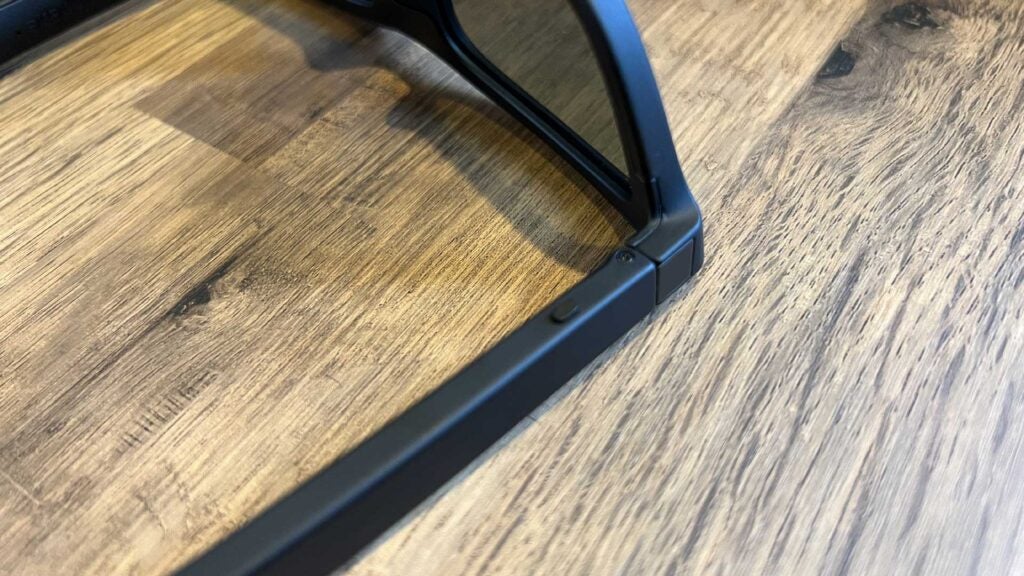

The underside of each temple has a tiny button right by the lenses: the right is dedicated to power, play/pause, call controls, and smart assistant summoning, with the left button devoted to cycling through polarization levels of the electrochromic lenses.
There are no touch controls here for switching tracks and no dedicated volume rocker. Unless you can memorise all the different ways to activate a single button, you’ll still often reach for your phone. Ampere’s more designer-focused Dusk Rx specs at least incorporate touch controls, but they do come at even more of a premium.
The lightly coloured and textured cardboard box the package ships in is of respectable quality. At the very least, the snappy magnet clasp hidden inside does give this expensive product a slight feeling of luxury. It’s largely recyclable, too, which is always appreciated.
Smart features
- Dimmable electrochromic lenses
- Bluetooth audio and control via a dedicated app
- One-button operation
When it comes to smart features, the Ampere Dusk is a relatively simple set of specs. Beyond the built-in audio via Bluetooth and the electrochromic lenses, there’s little else. There’s no camera like the Ray-Ban Meta specs, no built-in screens like the Xreal Air 2 Pro, nor even a sensor to automatically pause content when you take them off. That’s a small feature omission that’s frankly inexcusable for a premium audio-focused product.
The whole selling point of the Ampere Dusk specs is the electrochromic lenses – lenses you can dim to your heart’s desire. At the very least, the Ampere Dusk smart sunglasses can connect to a companion app to set custom incremental stages for the electrochromic dimming you can then toggle via the left temple button.
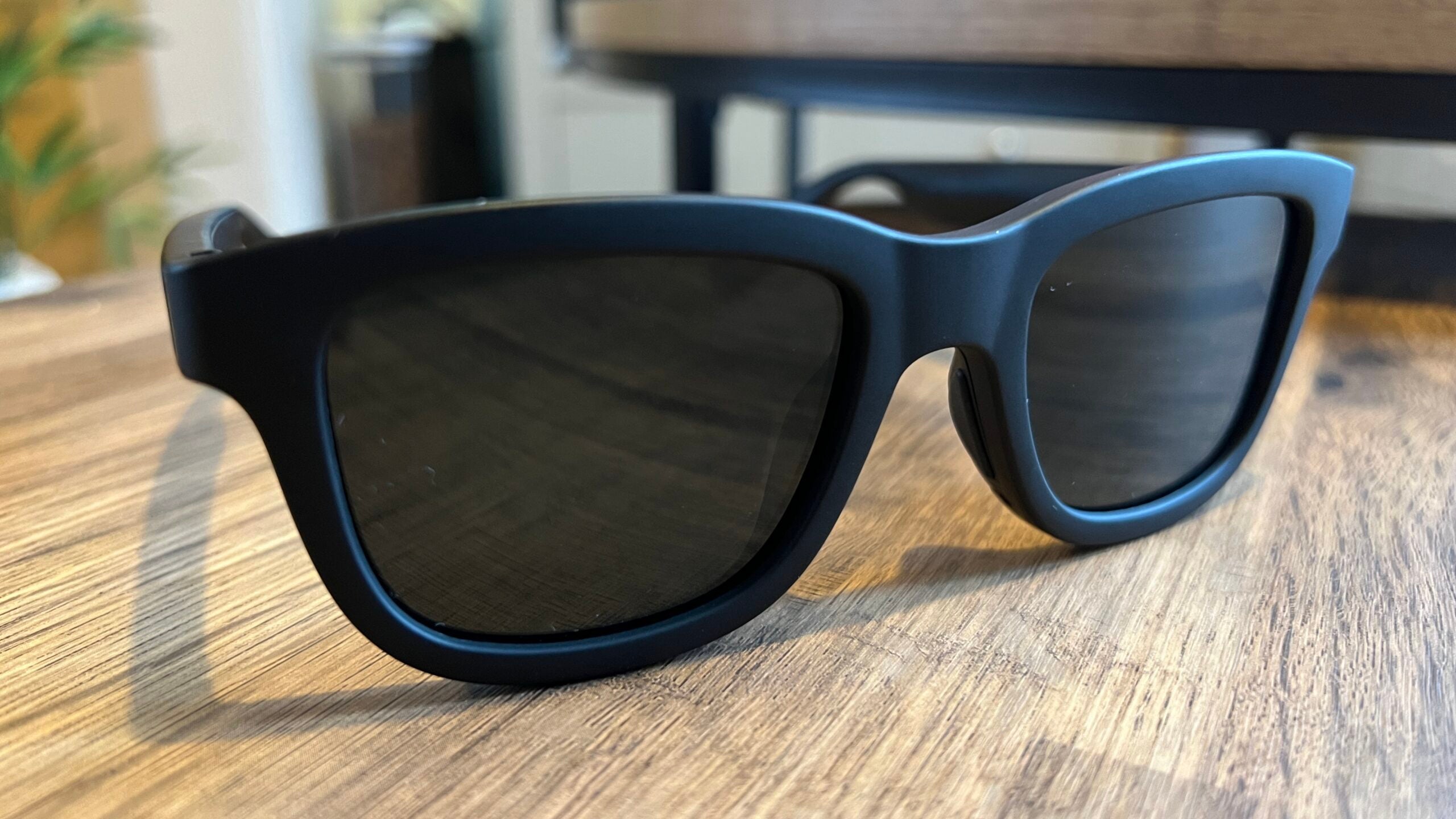
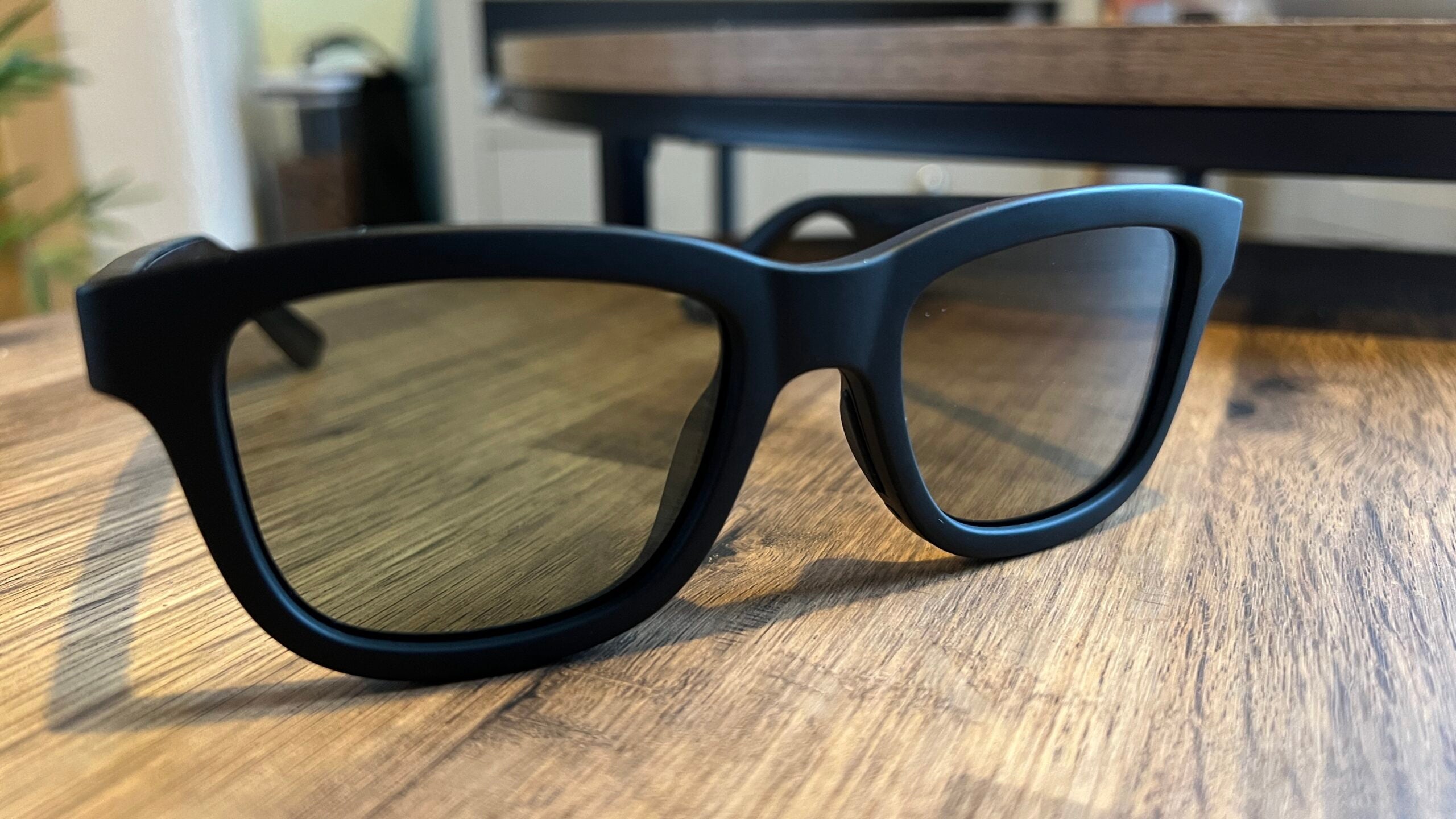
There’s also an EQ to dial in your preferred sound settings, but your device likely has one built in already, so it’s hard to give it extra marks there.
Neither of these settings will be saved to the specs themselves, meaning your personalization efforts won’t persist between connected devices or when you’re completely off the grid. You don’t have to connect to your smart device to use them as sunglasses, but you won’t get your preferred settings without doing so.
This is disappointing given there are certainly times you want to have personal control over the polarization effects without playing back music – in social situations, for example.
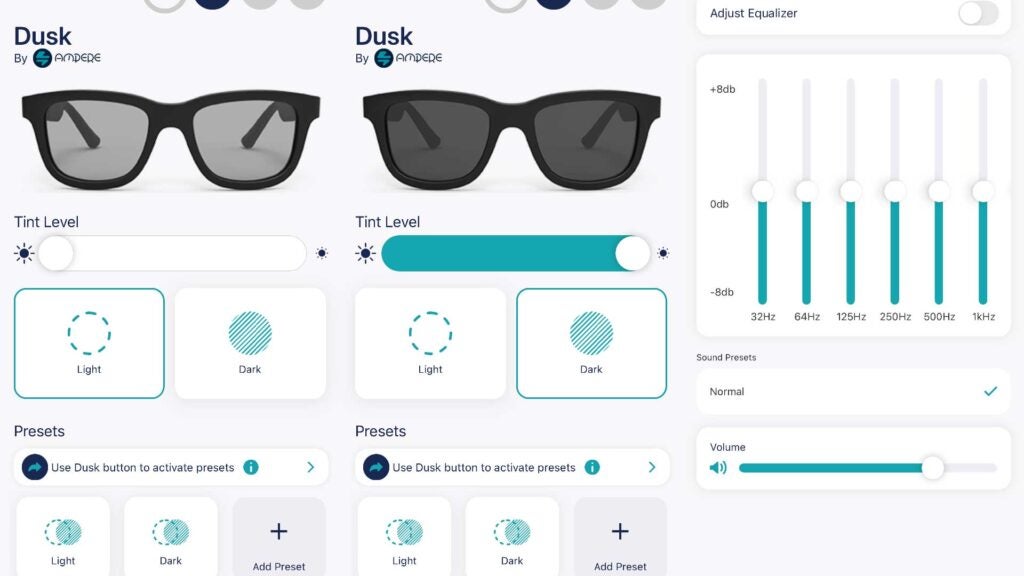

There were also plenty of times when the Ampere app reported incorrect information. This is largely related to the current dimming status not aligning with what was active. And while it wasn’t problematic, it was confusing in the first couple of hours of use. Until you’re familiar with just how opaque or transparent they can get, you’re bound to misjudge their potential when the app feeds you false data.
The biggest issue was the button on the left of the specs, dedicated to adjusting polarization, which didn’t work out of the box. Its simple operation meant I was sure it was just broken, which usually would have been a case for an immediate return and a sour taste in my mouth.
As it turns out, however, it can just sometimes decide it needs a reset. This only means holding the button down for three seconds, which the manual suggests, but it’s still hard to shrug off as a non-issue when it’s the only thing the button is there to do. It’s almost like it’s a known bug they can’t fix.
Audio
- Disappointing audio experience
- Can take and make phone calls
- Lots of sound leakage
It’s disappointing to report that the audio experience on the Ampere Dusk, one of its only two major features, just isn’t up to par. Next to the similarly priced Huawei Eyewear 2, sound quality seems like an afterthought next to the neat electrochromic lenses. If privacy and audio quality are something you demand on a sunlounger, you’re still going to want some dedicated earbuds on hand.
The audio is particularly harsh and tinny, with very little low-frequency bass. Listening to podcasts actively strained my sensitive ears. Even lower volumes, despite sounding quiet against my head, would still heavily leak out for others to hear due to the open placement of the single speakers.
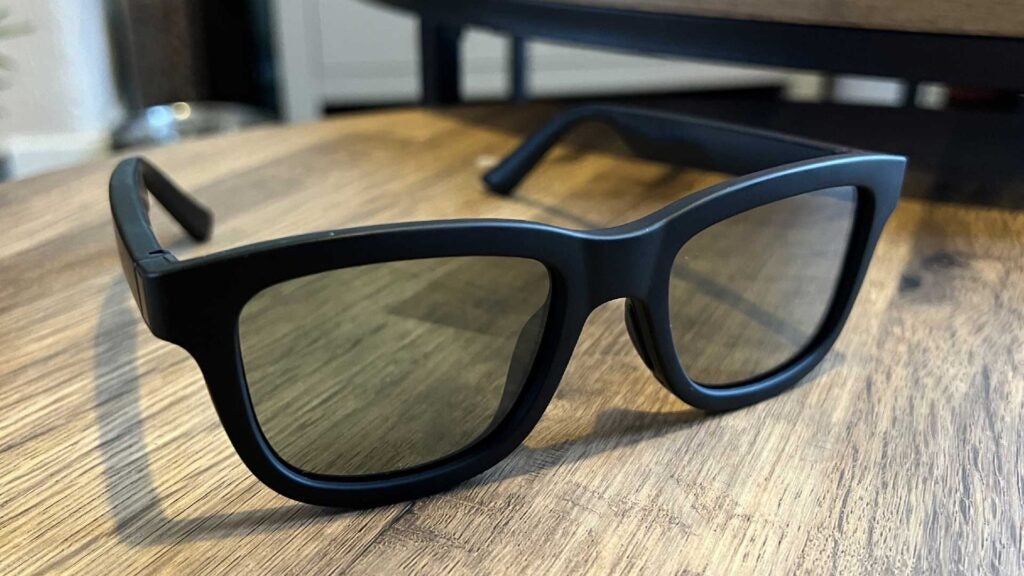

You can improve the situation with the in-app EQ, but don’t expect miracles in the sound quality department. There’s only one tiny speaker on either side of the Ampere Dusk, paling in comparison to the four total drivers on the more audio-focused Huawei Eyewear 2 specs. Like most, they’re also virtually unusable near busy roads.
When taking phone calls, things don’t change. Voices are intelligible, sure, but while the microphone quality was rated “fine” by those on the other end, a consistent comment was that I sounded distant. You’ll have to speak up to be heard no matter where you take your calls.
Accessories
- Included neoprene case won’t protect against much
- Cleaning cloth
- No charging brick
Shipping with the Ampere Dusk is a simple neoprene sleeve that won’t do much to save your specs from an accidental squash on the lounger or in your bag.
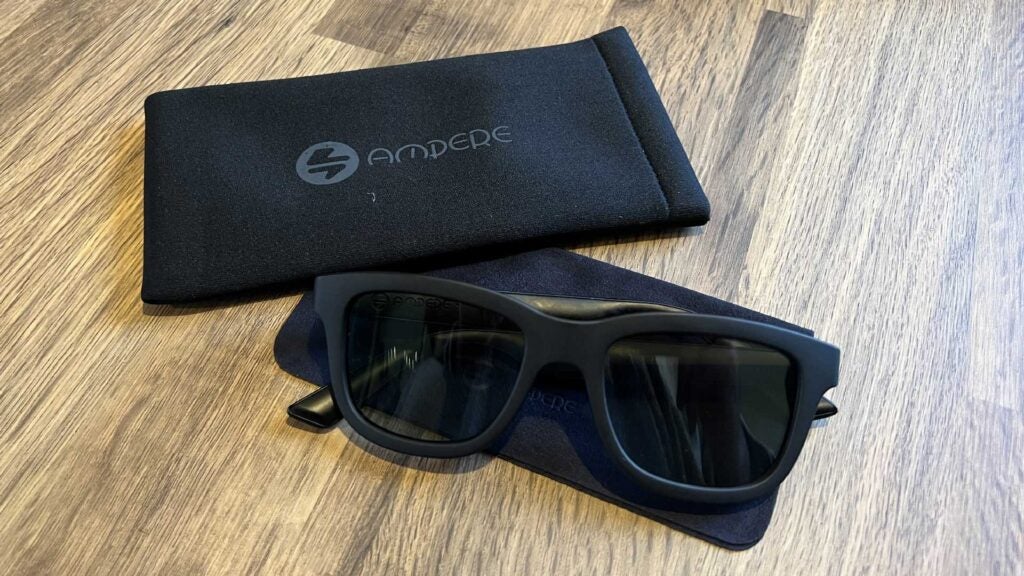

A drop or scrape will be fine, but that’s about it. It opens with a simple squeeze of the top, letting you slide them in well enough, but there’s no hard case included. They’re thin enough to fit most generic hard cases, which is a blessing, but given Ampere is ready and willing to sell you a chunky wireless charging case, it’s hard not to feel a little short-changed here.
Beyond a simple cleaning cloth and a sticker to test the polarization effects against without the sun, there isn’t much else outside of that permanent nose pad. Following recent trends, there’s no included wall plug, but the braided USB-C cable is of decent quality.
Battery
- 7-day battery for the lenses
- 4-hour battery for audio playback
- Charges via pogo pin magnetic connector
Though the battery in the Ampere Dusk is only rated at 110mAh, which will always look tiny compared to your average smart device, the specs can keep the electrochromic lenses running for a full week.
That battery life isn’t with the speakers in effect, however. When beaming calls or music from your phone, that respectable battery life dips to a paltry four hours. That’s more than the recommended time you should probably be spending in the sun, but it’s still difficult to imagine hooking them up to power that often.
Charging is managed via a magnetic pogo pin connector akin to the AJ01 specs. It isn’t as snappy as the Huawei Eyewear 2 approach of attaching to the stems of each temple, but it gets the job done. There’s just the concern of what happens should the cable get lost or break.
When charging, the Ampere Dusk glasses only need to be hooked up for 15 minutes to reach 80% charge. A full cycle will take 45 minutes according to the Ampere site, which is already a tall ask every few hours, but the manual states a full charge takes a whole hour.
Though it isn’t well documented, you can adjust the electrochromic dimming via the dedicated button even after the battery runs dry. You won’t be able to connect to the app to set new adjustment increments or fine-tune things, but at the very least, you can continue to use them as adjustable specs even if they won’t hold a connection for playing back music.
Should you buy it?
You want adjustable sunglasses that double as headphones
Though the audio experience is far from exemplary, the Ampere Dusk’s adjustable lenses work well in a variety of weather conditions.
You want wearables to replace your dedicated cans
At this price point, the subpar audio solution built into the Ampere Dusk smart sunglasses can’t replace dedicated wireless headphones or most earbuds.
Final Thoughts
At a recommended price of £300, the Ampere Dusk sunglasses aren’t worth the money. Had the audio quality been on par with the Huawei Eyewear 2, the proposition could have been a little easier to justify.
Instead, these specs rely too heavily on the electrochromic lenses to stand out in an increasingly competitive market. And even then, the four-hour battery life struggles against even the smallest earbuds, which we know from experience only leads to minor inconveniences.
Luckily, Ampere offers a pair without the disappointing audio gubbins for a slightly more appropriate £160 – the Dusk Lite. That way, you can get the nifty customizable levels of solar protection without feeling like you’ve spent almost double on a feature you don’t enjoy using.
Like the full-fat Dusk specs, they’re also frequently on sale for around £30 off. If you can grab them at £130, being able to tweak the level of tint throughout the day could be worth the price so long as you’re receptive to the simple design.
If you’re after the complete package, customizing something like the Ray-Ban Meta Glasses with photochromic lenses that match your prescription could very well create a best-of-both-worlds situation.
FAQs
The Ampere Dusk glasses charge via a magnetic pogo pin connection and a USB-C power adapter.
No, there’s no way to swap the lenses with prescription lenses.
















